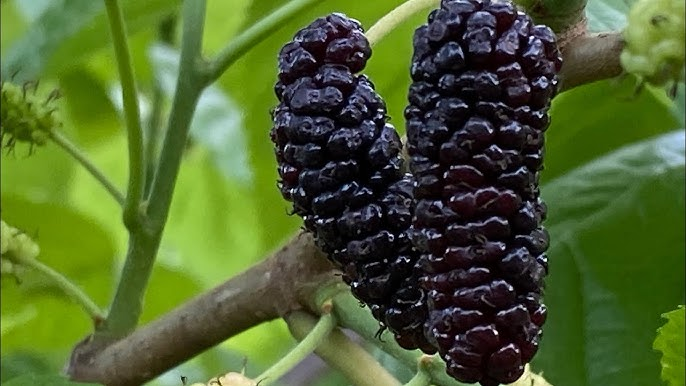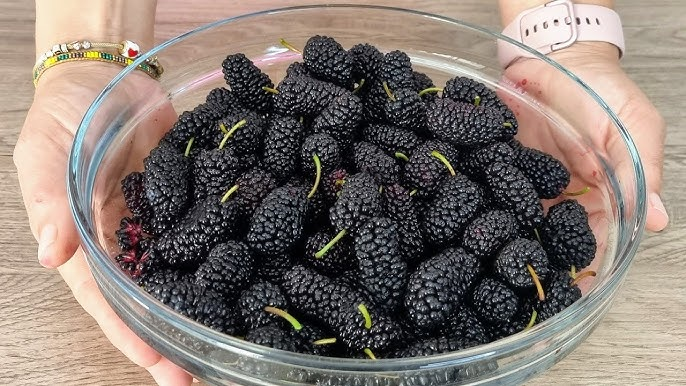Warm Introduction
Imagine a tree that provides lush shade, abundant edible fruit, natural habitat for wildlife, and even traditional healing benefits. That’s exactly what a mulberry tree offers! Whether you’re drawn to its sweet berries, its role as a beautiful shade tree, or its contribution to your garden ecosystem, planting a mulberry can bring lasting rewards.
In this complete guide, you’ll learn why the mulberry is ideal for modern gardens, how to plant and care for it, how to enjoy its harvest—and which mistakes to avoid along the way.
1. Outline & Word Counts
- Intro & Key Takeaway Bullets (~100 words)
- Why Plant a Mulberry? (~200 words)
- Health & Nutritional Perks (~300 words)
- Planting & Site Selection (~300 words)
- Care & Pruning Tips (~300 words)
- Harvest & How to Use Berries (~300 words)
- Common Mistakes & Fixes (~200 words)
- Regional & Seasonal Notes (~200 words)
- Tools & Materials Checklist (~100 words)
- FAQs (~200 words)
- Conclusion & Engagement (~100 words)
Total ~2,200 words
2. FAQs from “People Also Ask”
- How long until a newly planted mulberry bears fruit?
- Do you need more than one mulberry tree for pollination?
- Can mulberries thrive in pots?
- When is the best time to prune a mulberry tree?
- Are mulberry fruits messy or stain clothes?
3. LSI & NLP Keywords
- mulberry tree planting guide
- Morus alba vs Morus nigra
- prune mulberry tree tips
- harvest ripe mulberries
- mulberry health benefits
- container-grown mulberry
- mulberry shade tree
- mulberry fruit recipes
- mulberry medicinal uses
- sustainable edible landscaping
4. Internal Linking Opportunities
Early in the introduction, you can naturally include links to:
- composting for nutrient-rich soil — connects well to soil prep tips
- garden herbs and edible fruit trees — aligns with the mulberry’s dual ornamental + edible value
- organic pest control methods — complements pest monitoring advice
Why Plant a Mulberry Tree?
Mulberries are one of the most rewarding trees to plant in your garden. They grow quickly, offer valuable shade, attract wildlife, and produce delicious fruit—all while requiring relatively little maintenance once established.
Benefits include:
- Natural canopy — A dense crown provides cool shade and wind protection.
- Biodiversity boost — The tree supports bees, butterflies, birds, and beneficial insects.
- Edible bounty — Both leaves and berries offer nutritional and culinary value.
- Visual appeal — Lush foliage and a graceful form enhance your landscape.
A mulberry tree can also serve as a conversation-starter in school gardens and shared community spaces, making it a joy to grow and share.
Health & Nutritional Perks
The mulberry is a true superfood, with both its leaves and fruit offering an impressive array of nutrients and wellness benefits.
Nutrient Powerhouse
- Vitamins & Minerals — Mulberries are rich in vitamin C, potassium, iron, and fiber.
- Antioxidants — Darker varieties, especially black and red mulberries, contain anthocyanins that help fight free radicals and support heart health.
- Blood Sugar Support — Certain compounds in mulberry leaves help stabilize blood glucose and cholesterol levels.
- Weight Management — Mulberry leaf extracts have shown potential in aiding fat metabolism and insulin sensitivity.
Traditional Herbal Uses
For centuries, mulberry leaves have been used in herbal teas and remedies:
- Support for coughs, colds, and fever relief.
- Mild liver-supportive properties.
- Gentle detox support.
Mulberry leaves and berries are used both fresh and dried in teas, tinctures, and culinary recipes.
Planting & Site Selection

🌱 Choosing the Right Location
- Sunlight — Full sun promotes best fruiting; part shade is tolerated.
- Soil — Well-drained, fertile, loamy soil with neutral pH is ideal.
- Spacing — Plant at least 3 meters from buildings or underground utilities, as roots can spread significantly.
🌳 Selecting the Variety
- White Mulberry (Morus alba) — Cold-hardy and adaptable; milder-tasting fruit.
- Black Mulberry (Morus nigra) — Intense flavor; prefers warmer climates.
- Red Mulberry (Morus rubra) — North American native with sweet, aromatic fruit.
📅 Best Planting Time
Plant in fall or early spring, giving roots time to establish before summer heat or winter cold.
Care & Pruning Tips
Watering & Mulching
- During the first year, water weekly to help roots establish.
- Mature trees typically require supplemental water only in drought.
- Apply organic mulch (wood chips, straw) to conserve soil moisture—keep mulch a few inches away from the trunk.
Pruning Tips
- Timing — Always prune during dormancy (late winter or early spring).
- Formative Pruning — Encourage an open, spreading canopy for easier harvesting.
- Maintenance Pruning — Remove dead, crossing, or crowded branches to promote airflow and light penetration.
Pest & Disease Management
Mulberry trees are naturally resilient but occasional aphids or spider mites may appear. Regular inspection and early application of organic pest control methods will keep your tree healthy and productive.
Harvest & How to Use Berries
When & How to Harvest
Mulberries ripen gradually from late spring into summer (depending on climate and variety). Ripe berries pull off easily with a gentle tug.
For large harvests, spread a tarp under the tree and shake branches lightly to release mature fruit.
Culinary & Preservation Ideas
- Fresh eating — Delicious straight from the tree!
- Preserves — Make jam, jelly, or syrup.
- Baking — Add to muffins, tarts, or quick breads.
- Beverages — Use in smoothies or ferment into wine or liqueur.
- Drying — Dried mulberries are excellent in granola or trail mix.
Medicinal Uses
Dried leaves are popular for teas that may support blood sugar regulation and general wellness. Leaves can also be used for poultices and infused vinegars.
Common Mistakes & How to Avoid Them
| Mistake | Impact | Solution |
|---|---|---|
| Planting too close to structures | Risk of root damage | Maintain 3m distance |
| Pruning during active growth | Sap loss and stress | Prune only during dormancy |
| Overcrowding branches | Poor airflow and disease risk | Regular thinning cuts |
| Ignoring pests early | Aphid buildup and leaf damage | Monitor and apply controls early |
| Choosing the wrong variety | Poor fruiting or winter damage | Match variety to local climate |
Regional & Seasonal Tips
- Cooler climates — White mulberry is most frost-tolerant.
- Warmer climates — Black and red mulberries thrive in heat.
- Urban settings — Consider a fruitless cultivar if berry mess is a concern near patios or paths.
- Seasonal care — Apply mulch in late fall; prune in winter; fertilize lightly in early spring.
Tools & Materials Checklist 🛠️
- Healthy young mulberry tree (bare-root or potted)
- Rich compost or well-amended garden soil
- Stake and ties for young tree support
- Mulch materials (wood chips, straw, or leaf mold)
- Pruning shears and loppers
- Tarp or basket for harvesting
- Jars for preserves and syrups
FAQs
How long until a mulberry tree bears fruit?
3–5 years depending on species and growing conditions.
Do you need more than one mulberry tree for fruit?
No—most mulberries are self-fertile.
Can you grow mulberries in pots?
Yes, dwarf varieties can thrive in large containers with proper care.
When is the best time to prune?
Late winter to early spring before active growth resumes.
Do berries stain?
Yes—dark varieties can stain surfaces and clothing. Consider placement carefully.
Conclusion
Few trees offer as much value as the humble mulberry. Whether you plant it for the shade, the fruit, the wildlife habitat, or its wellness potential, this versatile tree will bring years of joy to your garden.
Have you grown a mulberry tree before? Share your tips or favorite recipes in the comments below—and don’t forget to explore our other resources on composting for nutrient-rich soil, garden herbs and edible fruit trees, and organic pest control methods to help your whole garden thrive.
Happy growing! 🌳😊
1️⃣ Anchor text: how to prune fruit trees effectively
URL: https://www.gardenersworld.com/how-to/grow-plants/how-to-prune-fruit-trees/
Suggested placement: In the Pruning Tips section — when discussing pruning mulberry trees during dormancy.
2️⃣ Anchor text: the nutritional benefits of mulberries
URL: https://www.nutrition-and-you.com/mulberries.html
Suggested placement: In the Health & Nutritional Perks section, when listing vitamins, minerals, and antioxidants in mulberries.
3️⃣ Anchor text: how to make mulberry jam at home
URL: https://practicalselfreliance.com/mulberry-jam/
Suggested placement: In the Harvest & How to Use Berries section, under culinary and preservation ideas (jams & preserves).


order amoxil pill – combamoxi purchase amoxicillin online
buy forcan tablets – https://gpdifluca.com/# diflucan generic
buy escitalopram 10mg – https://escitapro.com/# escitalopram 20mg pills
cenforce for sale online – cenforce 100mg price oral cenforce 100mg
canadian pharmacy cialis – https://ciltadgn.com/ cialis black review
buy cialis online overnight delivery – click cheap cialis with dapoxetine
is it legal to order viagra from canadian – sildenafil genfar 50mg where can i buy viagra in la
I am in point of fact enchant‚e ‘ to gleam at this blog posts which consists of tons of worthwhile facts, thanks for providing such data. https://buyfastonl.com/gabapentin.html
More posts like this would force the blogosphere more useful. sitio web
More articles like this would frame the blogosphere richer. https://prohnrg.com/product/priligy-dapoxetine-pills/
Thanks for sharing. It’s first quality. https://ursxdol.com/get-metformin-pills/
The thoroughness in this piece is noteworthy. https://aranitidine.com/fr/acheter-cenforce/
Palatable blog you possess here.. It’s obdurate to on great worth belles-lettres like yours these days. I justifiably appreciate individuals like you! Withstand vigilance!! https://ondactone.com/product/domperidone/
I’ll certainly carry back to be familiar with more.
order warfarin online
This is the gentle of scribble literary works I in fact appreciate. https://myvisualdatabase.com/forum/profile.php?id=118016
order dapagliflozin sale – this cost dapagliflozin 10 mg
orlistat tablet – this buy orlistat 60mg generic
You can conserve yourself and your dearest close being cautious when buying panacea online. Some pharmaceutics websites function legally and offer convenience, reclusion, bring in savings and safeguards to purchasing medicines. buy in TerbinaPharmacy https://terbinafines.com/product/zantac.html zantac
More posts like this would make the blogosphere more useful. TerbinaPharmacy
With thanks. Loads of expertise!
https://t.me/s/officials_pokerdom/3784
https://t.me/s/flagman_official_registration
https://t.me/s/dragon_money_mani